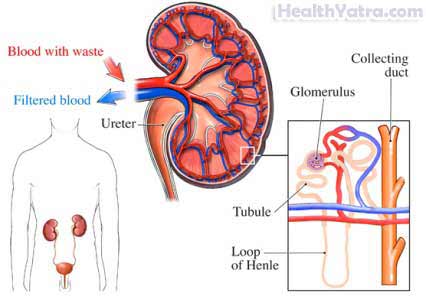সংজ্ঞা
Nephrotic syndrome happens when the kidneys let protein leak into the urine. When this happens, there is not enough protein in the blood. Low protein in the blood allows fluid to leak out of the blood stream and into body tissues.
Nephrotic syndrome is a collection of the following signs:
- High protein in the urine
- Low protein in the blood
- Swelling of body tissues
- High cholesterol in the blood
Nephrotic syndrome is not a disease itself. It is a set of signs and symptoms that indicate that another disease has damaged the kidneys, and that they are no longer working properly.
This is a serious condition that requires care from your doctor. Contact your doctor if you think you may have nephrotic syndrome.
কারণসমূহ
Nephrotic syndrome is caused by damage to tiny filters in the kidneys, called glomeruli. The glomeruli filter waste and excess water from the blood. This forms urine, which reaches the bladder via the ureters. Diseases that damage the glomeruli cause nephrotic syndrome.

Diseases that may lead to nephrotic syndrome include:
- Glomerulonephritis (inflammation of the glomeruli from infection or other causes)
- Diabetic nephropathy (kidney complications from diabetes)
- Membranous nephropathy
- Renal amyloidosis (abnormal protein deposits in the kidneys)
- Minimal change disease—This usually occurs in children when nephrotic syndrome occurs, even if there is little or no change to the structure of glomeruli or surrounding tissue.
- Other diseases, including systemic lupus erythematosus, certain infections, toxins, allergic reactions, sickle cell disease, renal vein thrombosis, and some types of cancer
ঝুঁকির কারণ
Tell your doctor if you have any of the following factors that increase your risk of nephrotic syndrome:
- কিডনি রোগ
- ডায়াবেটিস
- Lupus
লক্ষণ
উপসর্গ অন্তর্ভুক্ত হতে পারে:
- Swelling around the following body parts:
- চোখ
- মুখ
- পা দুটো
- Ankles
- Hands
- Abdomen
- Weight gain from excess fluids
- নিঃশ্বাসের দুর্বলতা
- দরিদ্র ক্ষুধা
- Foamy urine
- ক্লান্তি
রোগ নির্ণয়
Your doctor will ask about your symptoms and medical history. A physical exam will be done. High blood pressure may indicate kidney damage. A urine test will show if you have too much protein in your urine. A blood test will show if your blood contains too much cholesterol and not enough protein.
Other blood tests may be performed to determine the cause of the syndrome and to assess how well the kidney is functioning. If your doctor suspects nephrotic syndrome, you may be referred to a nephrologist (kidney specialist).
In some cases, a biopsy of the kidney is necessary to determine the cause of the syndrome and the best way to treat it. Imaging tests of the kidneys may also be useful in selected cases. These include:
- কম্পিউটেড টমোগ্রাফি (সিটি) স্ক্যান
- চৌম্বকীয় অনুরণন ইমেজিং (MRI)
- আল্ট্রাসাউন্ড
চিকিৎসা
Treatment depends on what is causing the nephrotic syndrome. Some cases are treatable with medicine, while others lead to kidney failure despite treatment. Besides directly treating the underlying cause, if possible, steps are taken to:
- Adjust your diet to replace protein lost in the urine
- Use ACE inhibitors to reduce protein loss (in some cases)
- Treat edema by restricting salt intake and taking diuretics (water pills)
- Lower cholesterol and blood pressure with diet, exercise, and medicines
Treatment Options for Selected Underlying Kidney Diseases
Minimal Change Disease
Most cases of nephrotic syndrome in children are caused by minimal change disease. This condition is treated with oral steroids, such as prednisone. If the child does not respond to treatment, the doctor may prescribe other medicines. Most children outgrow minimal change disease in their teen years and don’t have any permanent kidney damage.
Membranous Nephropathy
The most common kidney disease leading to nephrotic syndrome in adults is membranous nephropathy. Treatment for this condition is controversial. It usually involves medicines to suppress the activity of the immune system.
Dialysis and Kidney Transplants
If the kidneys stop functioning, dialysis or a kidney transplant is needed. A dialysis machine filters waste and excess water from the blood. Dialysis may be done until kidney function improves or a transplant is available.
প্রতিরোধ
Most conditions that lead to nephrotic syndrome cannot be prevented. However, the risk of type 2 diabetes may be reduced through exercise and weight control.
